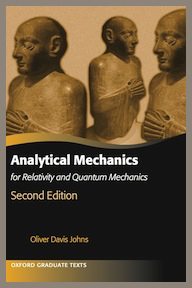Analytical Mechanics, 2nd edition
O. D. Johns
An innovative and mathematically sound treatment of the foundations of analytical mechanics and the relation of classical mechanics to relativity and quantum mechanics. Part I is an introduction to analytical mechanics, suitable for a graduate or advanced undergraduate course. Part II presents material designed principally for graduate students. The appendices in Part III summarize the mathematical methods used in the text.
The book integrates relativity into the teaching of classical mechanics. Part II introduces special relativity and covariant mechanics. It develops extended Lagrangian and Hamiltonian methods that treat time as a transformable coordinate rather than the fixed parameter of Newtonian physics, including an extended definition of canonical transformation that both simplifies the theory and no longer excludes the Lorentz transformation.
The book assists students who study classical mechanics as a preparation for quantum mechanics. Analytical mechanics is presented using methods—such as linear vector operators and dyadics—that familiarize the student with similar operator techniques in quantum theory and the dyadic Dirac notation. Comparisons to quantum mechanics appear throughout the text. For example, the chapter on Hamilton-Jacobi theory includes discussions of the closely related Bohm hidden variable model and Feynman path integral method. The chapter on angle-action variables concludes with a section on the old quantum theory.
Several of the fundamental problems in physics—the development of quantum information technology, and the problem of quantizing the gravitational field, to name two—require a rethinking of the quantum-classical connection. Graduate students preparing for research careers will find a graduate mechanics course based on this book to be an essential bridge between their undergraduate training and advanced study in analytical mechanics, relativity, and quantum mechanics.
New to the Second Edition:
Part I now contains chapters on Central Force Motion (chapter 11) and Scattering (chapter 12), and material on time-independent canonical transformations. Part II has a new chapter (chapter 22) on Angle-Action Variables.
These additions allow a more flexible use of the text. Part I is now a self-contained, introductory analytical mechanics text suitable for a one-semester course for beginning graduate students or advanced undergraduates. The instructor can then select a range of topics from Part II appropriate to the interests of more advanced students.
Paperback
The Second Edition has now been issued by OUP in paperback. The lower price should be of interest to professors who remember that many students have very little available money.
_________________________________________________


